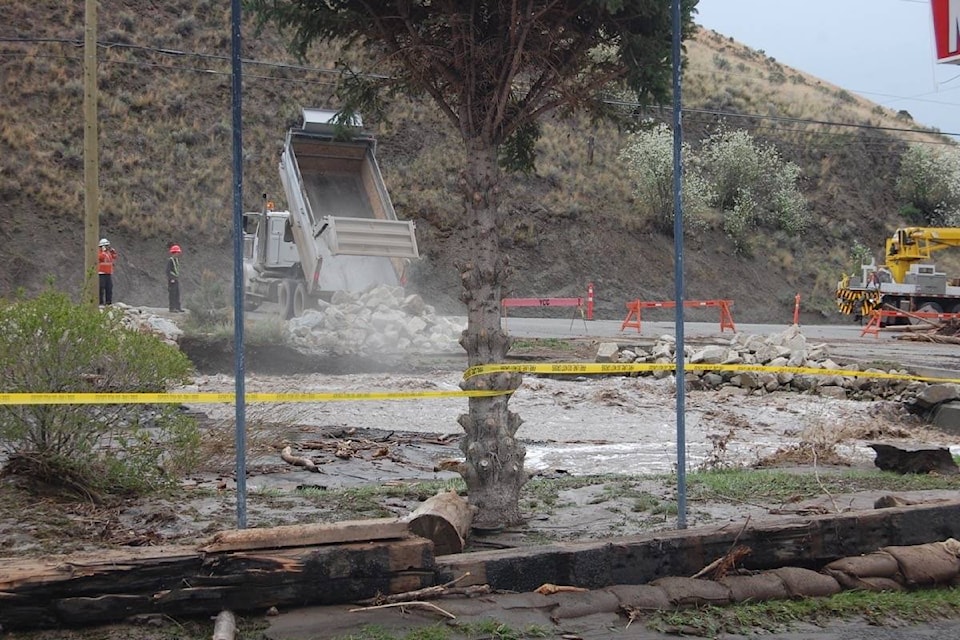A state of local emergency was declared by Cache Creek mayor John Ranta last week, in the wake of flooding on April 27–28 and the anticipation of more flooding when the Bonaparte River crests next week.
“It’s worse than it was in 2017,” said Ashcroft RCMP detachment commander Sgt. Kathleen Thain. “In terms of speed and volume, there’s no question about it.”
A higher than usual snowpack, combined with sudden high temperatures late last week, caused Cache Creek to breach banks and culverts starting at approximately 5 p.m. on Friday, April 27. Floodwater and debris swept through some sections of the village, damaging several buildings and flooding roads and parking lots, which caused the temporary closure of Highways 1 and 97 to and through the village.
Sandbags had already been placed outside the fire hall on Quartz Road, and more sandbags were deployed to ward off the rising water. The hall did not sustain any damage, but vehicles had been moved to outside the building as a precautionary measure in case the hall flooded, as it did in 2015 and 2017.
Village crew members, firefighters, local contractors, and volunteers worked through the night to prevent further flooding. On April 28, crews worked all day to clear debris and to place rip rap along Cache Creek near the Quartz Road culvert. Village staff and provincial officials are continuing to monitor the water level in Cache Creek, which carved out new channels below the Brookside Campground before receding on April 28.
“We expect to see [water levels in Cache Creek] go back up, but not to the degree of April 27,” said Thain. “We think we’ve seen the worst there.” With higher temperatures forecast for the next few days after cooler weather at the weekend, however, that situation could change.
Thain added that flooding in Cache Creek and in the Bonaparte River are being treated as two separate events this year. The Bonaparte was originally expected to crest on May 1 or 2, but that has now been pushed back to early next week. It was expected that this year’s water levels on the Bonaparte would be the highest in 20 years, but that forecast has been scaled back.
“The water is currently flowing [in the Bonaparte] at 22.7 cubic metres/second, and that was predicted to go up to 97,” said Cache Creek CAO Keir Gervais on April 30. “Now [the prediction] is for it to be down to 60.” He added that all properties along the Bonaparte have been sandbagged in anticipation of flooding, and praised the efforts of the volunteers who filled close to 10,000 sandbags during two work bees, the most recent one on April 28.
“The community response has been phenomenal.”
Cache Creek Elementary School was evacuated on the morning of April 27 because of rapidly rising water levels in the Bonaparte, with students bused to Desert Sands Community School in Ashcroft for the day. They were also sent to Desert Sands on April 30 and May 1 as a precautionary measure.
Anyone whose home is at risk from flooding is urged to take all necessary precautions, including moving valuables to higher ground and preparing a “grab and go” kit containing essentials such as medications.
The public is also being cautioned not to go near creek or river beds, as banks could be slippery, and undercut by rushing water so that they could easily give way. Parents should closely supervise their children and stress the importance of not going near the water.
Anyone working near watercourses should wear a personal flotation device, and should not work alone. Make sure there is at least one other person with you, so that emergency personnel can be quickly notified in case of an accident.
Never attempt to drive or walk in floodwater, since it can be deeper than it appears. A mere six inches of fast-moving water can knock over an adult. Two feet of rushing water can carry away most vehicles, including SUVs and pick-up trucks.
This is the third time in four years that Cache Creek has suffered devastating floods. In 2015 a heavy rainstorm in late May caused heavy flooding and extensive damage throughout the Village, while sudden snowmelt in early May 2017 caused more flooding and took the life of Cache Creek Volunteer Fire Department chief Clayton Cassidy, who was swept away by floodwater while checking creek levels.
editorial@accjournal.ca
Like us on Facebook and follow us on Twitter
